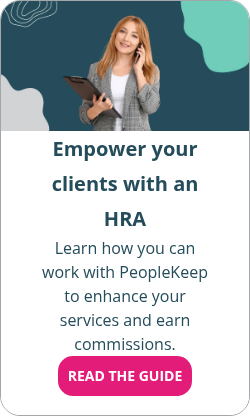How brokers can prepare for open enrollment
By Elizabeth Walker on September 26, 2025 at 9:15 AM
For most brokers, preparing for open enrollment starts early. Whether your client is doing an in-office open enrollment or using a virtual method, you must prepare for the process. This includes knowing the latest benefits options — such as health reimbursement arrangements (HRAs) — the barriers your clients face, and which benefits are most important to their employees.
Getting a jump on these tasks means you can consult with your clients on their priorities and financial situations. To help you out, this article will cover how open enrollment works, why early preparation is essential, and your post-open enrollment responsibilities.
In this blog post, you’ll learn:
- How open enrollment works, including deadlines, rules, and special enrollment periods.
- Why early preparation is critical for brokers to guide clients through HRAs, individual health insurance plans, and other benefit options.
- Practical tips and post-enrollment tasks to ensure your clients and their employees have a smooth experience.
How does open enrollment work?
For most people, open enrollment is a set time each year when they can enroll in employer-sponsored benefits.
Open enrollment can occur at any point in the year for companies offering a group health insurance plan, disability, life insurance, vision, or dental coverage. However, most companies select or change all their employee benefits during the fall to prepare for the new year.
However, with the rise of stand-alone HRAs, more people are enrolling in individual health insurance coverage.
Under the Affordable Care Act (ACA), Open Enrollment is the dedicated annual period when Americans can enroll in, renew, or change their health coverage on the individual market.
Open enrollment is an excellent time for your clients to review their benefits package to ensure they’re offering attractive perks that help recruit and retain talent. Evaluating their benefits and making small annual changes can be vital to a company’s success.
What are the enrollment deadlines?
Open Enrollment for Marketplace plans currently starts on November 1 and ends on January 15 in most states. However, a recent CMS final rule has changed the Open Enrollment process1.
Effective beginning the 2026 Open Enrollment Period for 2027 coverage, the dates to enroll in coverage will start on November 1 and end on December 15 for all states with public health exchanges operating on the federal Health Insurance Marketplace. State-based exchanges will also have to shorten their annual enrollment period to end by December 31.
A special enrollment period can also occur on a case-by-case basis. Suppose a person has a qualifying life event that triggers a special enrollment period, such as getting married or having a baby. In that case, they can enroll or change their health insurance plan outside the standard open enrollment period. Generally, a person has 60 days after a qualifying life event to enroll in a new health insurance plan through the federal or state marketplace.
For group plans, there’s no universal open enrollment deadline.
Why early preparation for Open Enrollment is important for your clients offering an HRA
Health benefits have changed significantly over the past few years, especially with HRAs rising in popularity. For brokers, Open Enrollment for HRAs is about guiding clients through their new benefit options, educating employees, and ensuring companies offer the best compensation package to their staff. Preparing before enrollment season is a good first step to helping you serve your clients.
Here are some reasons why early preparation is important:
- HRAs work differently from group plans. Giving your clients enough time to review all their options helps them understand how other benefits work, so they make an informed decision based on specific business needs instead of a gut reaction.
- Every employer’s situation is different. By starting early, you can tailor solutions to each client’s workforce size, budget, and goals. Taking a personalized approach to their unique needs can lead to more benefit renewals, reduced benefit costs, and improved employee satisfaction.
- Many employees will be new to shopping for individual health insurance plans. If you’ve prepared your clients in advance, they’ll have the right tools and resources to share with their workforce, reducing stress and confusion during enrollment.
- Offering HRAs requires employers to follow specific compliance rules, reporting requirements, and federal laws. Early preparation ensures you and your client don’t miss any necessary steps or deadlines, like providing an HRA notice.
- Switching from group coverage to individual health plans brings new questions and challenges. Preparing in advance gives you the information you need to guide your clients effectively and answer any questions they may have.
Tips to help you prepare for open enrollment
Here are key steps you can take to make open enrollment run smoothly for your clients:
- Learn about alternatives to group health insurance, like HRAs.
- Employers offering a group health plan typically just give their employees one or two policies to choose from. However, a stand-alone HRA is a flexible and cost-effective alternative. These personalized benefits allow employers to provide their staff with tax-free reimbursements for their health insurance premiums and qualified out-of-pocket costs. Additionally, HRAs allow employees to choose their own health coverage and other medical expenses.
- Review your client’s needs.
- If your client struggles with rising group plan costs, show them how HRAs can be the solution. For example, if a client faces a steep annual rate increase, switching to an individual coverage HRA (ICHRA) could save them time and money. Likewise, a qualified small employer HRA (QSEHRA) is often an affordable option for small clients with limited budgets. Individual plans are community-rated, so they tend to have more stable rate increases each year, regardless of your client’s benefits utilization.
- Know the enrollment deadlines in your state.
- Timing is critical, especially when a new benefit is in place. A client transitioning from a group health plan to an HRA should make the switch before the ACA Open Enrollment period begins. This ensures employees can shop for individual coverage during the annual enrollment window. However, mid-year enrollments are possible thanks to an SEP.
- Complete your Federally Facilitated Marketplace (FFM) certification2.
- If your client adopts an HRA, you’ll need this certification to assist your client’s employees with finding qualified individual health coverage so they can participate in a QSEHRA or ICHRA.
- Alternatively, your client’s employees can shop for health coverage on their own or through an HRA administrator like PeopleKeep or Remodel Health.
- Familiarize yourself with changes in the health benefit industry.
- If your client wants to offer other benefit options during open enrollment, you must also prepare for those. Monitor carrier updates, new plan offerings, rate changes, and shifts in employee benefit preferences. For example, today’s workers increasingly value mental health services, family planning assistance, and wellness services in addition to comprehensive medical coverage.
- Schedule check-in meetings with your clients.
- Set up meetings before open enrollment to discuss benefit options, answer questions, and ensure clients make the best choice for them and their staff.
- Prepare forms, resources, and other enrollment materials.
- Have forms, acknowledgment documents, online application links, and setup instructions ready in advance. The smoother the process, the more secure your clients will feel every step of the way.
- Start researching and pulling quotes so your clients can review their options early.
- Begin gathering plan options and cost comparisons well before open enrollment. Early preparation helps clients make smart choices without the stress of impending deadlines.
Post-open enrollment tasks
Your responsibilities don't stop when the open enrollment ends. Before you can wrap up the season, you still have obligations to your clients.
The following are some key post-open enrollment tasks you can take:
- Make sure your clients have everything they need to administer their HRA effectively. If your client decides to manage their HRA with PeopleKeep by Remodel Health, our award-winning customer support and benefits team can help you design and administer your benefit in just a few minutes each month.
- For clients moving from a group plan to individual coverage, double-check that employees have successfully enrolled in their on- or off-exchange plans. If you have clients still on a traditional group policy, ensure they have all benefit plan details, vendor contact information, payroll deduction instructions, and other relevant information.
- Offer your clients’ employees resources such as FAQs, step-by-step guides on submitting HRA reimbursements, and plan administrator contact information. You should also assist your clients with IRS reporting requirements and other compliance regulations.
- Schedule post-enrollment check-ins to discuss how the process went and what you could improve for them the following year. This is particularly important with first-time HRA adopters, as feedback will help fine-tune the process moving forward.
- Lastly, review and audit your resources and materials to streamline future open enrollment seasons and strengthen your position as a trusted advisor.
Conclusion
The health insurance industry is constantly changing, so it’s never too early to start planning for open enrollment. Securing the right kind of benefits for your clients takes time and research. You don’t want to be left feeling like you’re racing against the clock when helping your clients make crucial decisions for their business. With a personal touch and proper preparation, you can get your clients through open enrollment season with fewer hassles and delays.
This article was originally published on September 14, 2022. It was last updated on September 26, 2025.
1. Patient Protection and Affordable Care Act; Marketplace Integrity and Affordability
2. Registration and Training for Health Insurance Marketplace Agents and Brokers
Check out more resources
See these related articles

How to grow your insurance book of business with an HRA
Want to take your insurance book of business to the next level? Explore the power of an HRA and learn how to leverage it for quicker growth in this guide.

What is the Affordable Care Act (ACA)?
The Affordable Care Act (ACA) expanded access to health insurance. Learn what the ACA is, what it requires, and how it impacts individuals and employers.

Common types of health insurance plans
Learn the pros and cons of the most common types of health insurance plans, such as PPOs, HMOs, HSA-qualified plans, indemnity plans, and alternatives.



